

The Science of Surprise. For tourists, september on the Côte d'Azur is a time for soaking up the last rays of summer and for gambling at Monte Carlo's famous casino.
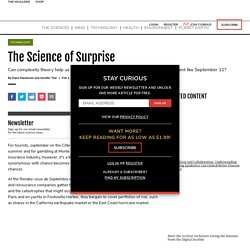
For executives in the insurance industry, however, it's a time for serious business. Every fall, the city that is synonymous with chance becomes the world capital for people who hate to take chances. At the Rendez-vous de Septembre each year, representatives of the world's insurance and reinsurance companies gather for one week to assess global market conditions and the catastrophes that might occur in the coming year. Over cocktails at the Café de Paris and on yachts in Fontvieille Harbor, they bargain to cover portfolios of risk, such as shares in the California earthquake market or the East Coast hurricane market. Pretty pictures: Can images stop data overload? Pretty pictures: Can images stop data overload? 16 April 2012Last updated at 19:01 ET By Fiona Graham Technology of business reporter, BBC News Brain scan: Research suggests that one way to avoid being overloaded by data is by presenting it visually rather than text or numbers Sitting at your desk in the middle of the day, yet another email notification pops up in the corner of the screen, covering the figures you're trying to digest in the complicated spreadsheet in front of you.

Your laptop is open on the desk next to you with another set of figures you need - meanwhile you're frantically tabbing through different documents on the main screen. Brainwave Experiment Visualizes Storytelling's Effects on the Mind. Image courtesy the artists.
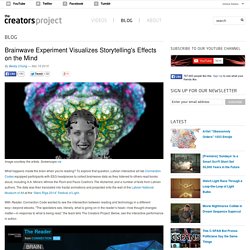
Screencaps via What happens inside the brain when you're reading? The Role of Neuroscience in Psychiatry Redux. Neuroskeptic has launched the “mother of all blog posts” against my article, published earlier this week.

Neuroskeptic is skeptical that there is a “War Between Neuroscience and Psychiatry.” I fully agree. There is NOT a war and I regret the first title that was published with my piece. I did not choose “War Between Neuroscience and Psychiatry” and was grateful when the editors changed the title to “Why Psychiatry Needs Neuroscience” at my request. I’m thrilled that Neuroskeptic was so engaged by my piece. Frontiers in Evolutionary Neuroscience. Neurosciência e Comportamento, Instituto de Psicologia, Universidade de São Paulo, São Paulo, Brazil Studies of culturally-based phenomena within neuroscientific frameworks represent one of the most dynamic tendencies in contemporary cognitive science.
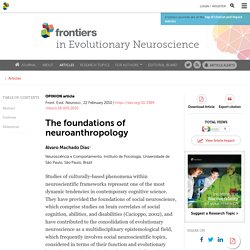
They have provided the foundations of social neuroscience, which comprise studies on brain correlates of social cognition, abilities, and disabilities (Cacioppo, 2002), and have contributed to the consolidation of evolutionary neuroscience as a multidisciplinary epistemological field, which frequently involves social neuroscientific topics, considered in terms of their function and evolutionary basis (for an authoritative introduction and discussion: Platek, Keenan, & Shackelford, 2007).
Studies of culturally-based phenomena within neuroscientific frameworks represent one of the most dynamic tendencies in contemporary cognitive science. Neuroanthropology: a humanistic science for the study of the culture–brain nexus. Skip to Main Content Advertisement Search.
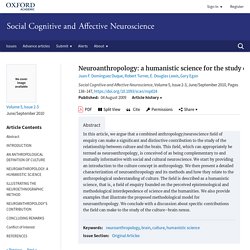
Neuroanthropology – a Humanistic Science for the Study of the Culture–Brain nexus. Neuroanthropology – a Humanistic Science for the Study of the Culture–Brain nexus In this article, we argue that a combined anthropology/neuroscience field of inquiry can make a significant and distinctive contribution to the study of the relationship between culture and the brain.

This field, which can appropriately be termed as neuroanthropology, is conceived of as being complementary to and mutually informative with social and cultural neuroscience. Anthropology of the Brain: Consciousness, Culture, and Free Will. Anthropology of the Brain: Consciousness, Culture, and Free Will In this unique exploration of the mysteries of the human brain, Roger Bartra shows that consciousness is a phenomenon that occurs not only in the mind but also in an external network, a symbolic system.
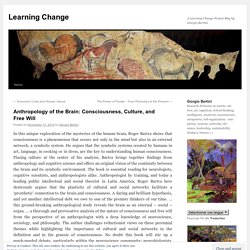
He argues that the symbolic systems created by humans in art, language, in cooking or in dress, are the key to understanding human consciousness. Anthropology of the Brain: Consciousness, Culture, and Free Will - Roger Bartra. Meme selection. Francis HEYLIGHEN CLEA, Free University of Brussels, Pleinlaan 2, B-1050 Brussels, Belgium E-mail: fheyligh@vub.ac.be, To be published in: Proc. 15th Int.

Congress on Cybernetics (Association Internat. de Cyberné tique, Namur). ABSTRACT. Portal:Evolutionary biology. Category:Population genetics. The objectivity thing (or, why science is a team sport). One of the qualities we expect from good science is objectivity.
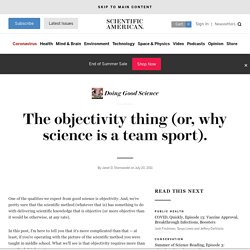
And, we're pretty sure that the scientific method (whatever that is) has something to do with delivering scientific knowledge that is objective (or more objective than it would be otherwise, at any rate). In this post, I'm here to tell you that it's more complicated than that -- at least, if you're operating with the picture of the scientific method you were taught in middle school. What we'll see is that objectivity requires more than a method; it takes a team.
(I'll briefly note that my discussion of objectivity, subjectivity, and scientific knowledge building owes much to Helen E. Divination. Divination: The Synchronous Universe. Divination (from the Latin divinare "to foresee, to be inspired by a god", related to divinus, divine) Article: By Alex Whitaker 2011 Although today divination is largely considered to be a false 'science', there is no doubt that in the past a great emphasis and respect was placed on those who claimed to be capable of it.
Divination methods vary by culture and religion but in all cases, divination relies on a symbolic key to decipher the underlying meaning of physical events. Psychedelics As Tools For Spirituality. As Timothy Leary put it, a psychedelic experience is “a period of increased reactivity to stimuli both from within and from without.” In a YouTube video, freestyler Jason Silva eloquently discusses the potential for exploration of consciousness that psychedelics offer. In fluid, poetic detail complete with trippy music and visual effects, he explores the psychedelic experience, and spiritual realization. He uses Leary quotes and personal observations to show how, often, the two go hand in hand.
At both the start and finish of the video Silva includes a shout-out to the nonprofit, independent Multidisciplinary Association for Psychedelic Studies (MAPS). Looking At Tears Under A Microscope Reveals A Shocking Fact. Share on Facebook One day Rose-Lynn Fisher wondered if her tears of grief would look different from her tears of joy, so she began to explore them up close under a microscope. She studied 100 different tears and found that basal tears (the ones that our body produces to lubricate our eyes) are drastically different from the tears that happen when we are chopping onions. The tears that come about from hard laughter aren’t even close to the tears of sorrow.
Humans Have a Lot More Than Five Senses. Today I found out humans have a lot more than five senses. It turns out, there are at least nine senses and most researchers think there are more like twenty-one or so. Just for reference, the commonly held definition of a “sense” is “any system that consists of a group of sensory cell types that respond to a specific physical phenomenon and that corresponds to a particular group of regions within the brain where the signals are received and interpreted.” The commonly held human senses are as follows: Sight: This technically is two senses given the two distinct types of receptors present, one for color (cones) and one for brightness (rods).Taste: This is sometimes argued to be five senses by itself due to the differing types of taste receptors (sweet, salty, sour, bitter, and umami), but generally is just referred to as one sense.
For those who don’t know, umami receptors detect the amino acid glutamate, which is a taste generally found in meat and some artificial flavoring. Your Mind & Body Are Not Separate. This Chart Explains It All. Activity levels in mums and children 'directly linked' 24 March 2014Last updated at 02:02 ET The more active a mother is, the more physically active her child will be, suggests a UK study of 500 mums and four-year-olds. But many mothers' exercise levels fell way below recommended levels, it said. Researchers from Cambridge and Southampton universities used heart-rate monitors to measure activity levels over seven days. The study, published in Pediatrics, said policies to improve children's health should be aimed at mothers. The Neuroanthropology of Embodiment, Absorption, and Dissociation. Second Brain Found in Heart Neurons - Trust your Gut Feelings.
Selfish traits not favoured by evolution, study shows. The Encultured Brain: An Introduction to Neuroanthropology. Neuroanthropology – Understanding the encultured brain. Neuroanthropology: a humanistic science for the study of the culture-brain nexus. - Abstract. The Use of Social Networking in Education. A New Media Approach For Improved Sense-Making Through Physiological Coherence. Negotiation Examples: How Crisis Negotiators Use Text Messaging.
Fitness landscape. Ingenious Genes: How Gene Regulation Networks Evolve to Control Development - MIT Press Scholarship. Reviewable. How We Create Reality. Remembering Richard Lewontin: A Tribute From a Student Who Never Got to Meet Him - This View Of Life. CogZest – Thrive in the Sea of Knowledge. The Average Women Faces In Different Countries. Curious study calculates the “average” female face for each country. 3000 Years Of Women’s Beauty Standards In A 3 Minute Video.
Requires subscription. Science Reveals Artists Really Do Have Different Brains. Drawing on the right side of the brain: A voxel-based morphometry analysis of observational drawing. Neuroscience of Learning. Unique Me as an Adolescence. BioEthics. Genomics. Art Reflects Culture, Shapes Minds. Ways We Learn. Creative Processes. Cultural Evolution. Health Aberrations. Neuro Calcs. Social Norming.